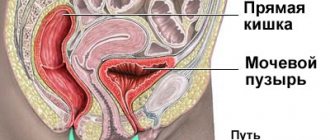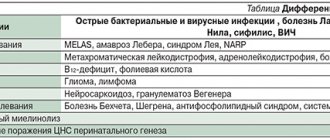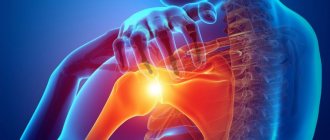The article was checked by general practitioner Mardanova O.A. , is for general informational purposes only and does not replace specialist advice. For recommendations on diagnosis and treatment, consultation with a doctor is necessary.
It is believed that respiratory diseases are one of the most common pathologies with which patients consult a doctor. They significantly reduce the patient’s quality of life and are often difficult to treat independently. In addition, the state of the respiratory system is seriously influenced by the environment, including the ecological situation, and therefore the number of patients with these diseases has increased significantly in recent years.
Therapists at the Yauza Clinical Hospital diagnose respiratory diseases and refer patients to doctors whose specialty is respiratory treatment.
Respiratory diseases: causes
The causes of this group of diseases are very diverse. Let's consider the main ones: 1. The No. 1 cause of respiratory diseases are pathogenic microorganisms - causative agents of infectious processes, and the leading role in this cause belongs to bacteria such as: mycoplasma, pneumococcus, legionella, hemophilus influenzae, chlamydia, respiratory viral infections, influenza viruses . Respiratory diseases are usually caused by one type of foreign agent (monoinfection), but sometimes pathogens can be of several types (mixed infection). 2. The second most important cause of respiratory diseases are external allergens. Most often, such allergens are plant pollen (wormwood, nettle, dandelion, buttercup, lilac, poplar, birch...), fungal spores... Allergens cause so-called autoimmune diseases of the respiratory system (the actions of the immune system are directed at the tissues of the body’s own). Also, allergens that cause respiratory diseases include: - animal allergens (contained in fur, dander, saliva, urine of animals...); - household allergens (house dust, human skin particles, house mites...); — allergens of yeast and mold fungi. — food allergens; - various medications... Provoking factors for the occurrence of respiratory diseases may include: - bad human habits (smoking and alcohol abuse); — unfavorable environmental conditions; - other pathologies, such as diabetes, cardiovascular diseases...; - any reasons leading to disruption of the immune system.
Respiratory diseases: symptoms
The symptoms of this group of diseases are quite pronounced and it is simply impossible to confuse them with any others. 1. The most common symptom of respiratory diseases is shortness of breath. It can be different: physiological (during physical exertion) and pathological (against the background of some diseases), inspiratory (difficulty inhaling), expiratory (difficulty exhaling), mixed. A severe form of shortness of breath is suffocation. 2. The second most common symptom is cough. It can be: - dry (without sputum production); — wet (with sputum production); - permanent (with inflammation of the bronchi and larynx...); - periodic (with pneumonia, acute respiratory infections, flu...). 3. Hemoptysis is a rare symptom, but characteristic only of respiratory diseases (sometimes heart diseases). Most often, hemoptysis occurs with tuberculosis, cancer or lung abscess). 4. Another important symptom of respiratory disease is pain. Pain can be localized in different parts of the body (chest, throat, location of the trachea...), it can be of different intensity and of a different nature, but it always affects the patient’s breathing.
ABSCESS OF THE LUNG
Lung abscess
- a pathological process characterized by the formation of a limited cavity in the lung tissue as a result of its necrosis and purulent melting.
Main pathogens
Development of a lung abscess
binds primarily to anaerobic flora -
Bacteroides
spp.,
F. nucleatum, Peptostreptococcus
spp.,
P. niger
- often in combination with enterobacteria (due to aspiration of oropharyngeal contents).
Choice of antimicrobials
Drugs of choice
: amoxicillin/clavulanate, ampicillin/sulbactam or cefoperazone/sulbactam IV; benzylpenicillin intravenously, then amoxicillin orally (step therapy); benzylpenicillin + metronidazole IV, then amoxicillin + metronidazole orally (stepped therapy).
Alternative drugs
: lincosamides + aminoglycosides of II-III generation; fluoroquinolones + metronidazole; carbapenems.
Duration of therapy
determined individually.
Diagnosis of respiratory diseases
Methods for diagnosing this group of diseases are very diverse; we will consider the simplest and most common ones. The first step in diagnosing respiratory pathologies is to examine patients. With its help, possible pathology of the chest shape is identified, the type of breathing, its rhythm, depth and frequency are determined. Palpation is carried out to assess vocal tremor; for example, with pneumonia it can be enhanced, and with pleurisy, on the contrary, it can be weakened. Breathing is assessed using auscultation (hard breathing is observed in bronchitis, dry rales are heard in bronchial asthma, and moist rales are clearly audible in pneumonia or lung abscess). Using percussion, a decrease in the amount of air in the lungs is detected, as well as their boundaries are determined. Among other things, there are: 1) Instrumental and laboratory methods for diagnosing respiratory diseases: a) The most common and important method of instrumental diagnosis is X-ray studies: - fluoroscopy; - fluorography; — tomography; - radiography; — bronchography b) Endoscopic studies: — bronchoscopy; — thoracoscopy. 2) Methods for functional diagnosis of respiratory diseases: a) Tests to detect respiratory failure. b) Ergospirography. c) Microscopic examination of sputum. Diagnosis of respiratory diseases plays quite a huge role in the treatment of this group of pathologies: the faster and more accurately the disease is identified, the higher the chances of success in its treatment.
The structure of the respiratory system
The respiratory organs form one of the most important systems in our body. At the same time, their functionality is much broader than saturating cells with oxygen and removing carbon dioxide. For example, the larynx is also a respiratory organ, which is also part of the vocal apparatus. And in the lungs themselves, in addition to gas exchange, the most important process of maturation of blood cells occurs. Let us examine the structure of these organs in more detail.
The respiratory system consists of the respiratory organs and airways.
Respiratory organs include:
- lungs
- Airways
- throat
- larynx
- trachea
- bronchi and bronchioles
Also included in the respiratory system are the intercostal muscles and the diaphragm, since they make contraction of the lungs possible.
Major respiratory diseases
1. Bronchitis. Today it is the most common respiratory disease, which is characterized by damage to the bronchi. The main symptom of this pathology is cough. Bronchitis can be chronic or acute. 2. Bronchial asthma. Autoimmune disease of the respiratory system of chronic nature. Main symptoms: difficulty breathing, attacks of severe suffocation and coughing, wheezing. 3. Pneumonia. An infectious and inflammatory disease of the respiratory system, characterized by damage to lung tissue by various foreign agents (bacteria, viruses, protozoa, fungi...). The main symptoms of this disease: chest pain, cough, general weakness, shortness of breath, elevated body temperature... 4. Pleurisy. It is characterized by inflammation of the pleura, the membrane around the lungs. Most often, pleurisy occurs as a complication of other respiratory diseases. 5. Chronic obstructive pulmonary disease (COPD). It is characterized by inflammatory processes in the bronchi of a non-allergenic nature, as a result of which gas exchange processes in the body are disrupted. The main symptoms of this pathology: shortness of breath accompanied by a wet cough. 6. Interstitial lung diseases. A group of respiratory diseases characterized by inflammatory processes in the walls of the alveoli. 7. Respiratory distress syndrome. Characterized by acute respiratory failure due to damage (for various reasons) to the lungs. 8. Bronchiectasis. It is characterized by purulent processes in the lower sections of the bronchi due to their expansion. This disease is chronic. Symptoms: chest pain, shortness of breath accompanied by a cough with purulent sputum.
Pneumonia
Pneumonia is a disease usually caused by a bacterial or viral infection. Its danger is that in some forms it can be asymptomatic or with vague symptoms. The acute form usually resolves within 2-3 weeks with proper treatment. Chronic can bother you for several months and even years.
Symptoms of pneumonia
The disease is accompanied by the following symptoms:
- dry cough that gets worse in the absence of proper treatment;
- increased body temperature;
- headaches and muscle pain;
- fatigue, general weakness;
- chest pain when coughing;
- heavy breathing and signs of lack of oxygen - lips and nails acquire a bluish tint.
In the later stages of pneumonia, there may be blood in the sputum coughed up, nausea and vomiting, and a feeling of suffocation.
Treatment of pneumonia
Treatment of acute pneumonia is based on antibacterial therapy. Patients are also prescribed antibiotics, including if the disease is viral, to prevent secondary infection. In addition, broad-spectrum antibiotics help reduce the risk of complications. Treatment of pneumonia with timely consultation with a doctor continues for 1-2 weeks, depending on the causative agent of the disease.
Treatment of respiratory diseases
Treatment of pathologies of the respiratory organs of each person is always individual and must take into account many factors: the immune status of the patient, the individual characteristics of the body, changes in it caused by the disease... The most common method of treating respiratory diseases is medication. Here are the main groups of drugs for this: - antitoxic agents (neocompensan, polyvinol, cyanocobalamin...); — antimicrobial drugs; - anti-inflammatory drugs (reopirin, hydrocortisone, butadione, galascorbine...); - expectorant drugs (to remove pathological accumulations from the body); - antitussives (amesil, codeine...); - bronchodilators (adrenaline, euphilin...); - painkillers (analgin, amidopyrine...); - breathing stimulants; - antihistamines and antiallergetics. In cases where drug methods of treating respiratory diseases are ineffective and the pathology causes serious complications, they resort to surgical intervention, which is divided into the following groups: - pleural surgery; — operations on the bronchi and trachea; — pulmonary resection (partial or complete removal); — surgery for lung cavities; — collapse surgical interventions. Attention! It is necessary to take into account that all medications for the treatment of respiratory diseases have certain contraindications and cause quite serious side effects, have a negative effect on the microflora of the stomach - the most important part of the immune system, which must be known when prescribing a method of therapy. Today, a new paradigm in the treatment of respiratory diseases has matured: scientists have come to the conclusion that it is more important to support the immune system (IS) in its fight against foreign agents, and not to directly influence these agents, although in severe cases, of course, there is no time to restore optimal functionality of the IS. It is for this reason that complex therapy for these pathologies is necessary, in which, along with traditional drugs, it is necessary to use immunomodulators and immunostimulants. One of the best drugs in this line is Transfer Factor. The immune particles of the same name, on the basis of which it is produced, when entering our body, perform the following functions: - neutralize the side effects caused by drugs; - strengthens the body's immunity; - enhances the therapeutic effect of the medications used; - quickly restores the body. And to neutralize the negative effects of drugs on the microflora of the gastrointestinal tract, the comprehensive use of probiotics and prebiotics is mandatory.
Prevention of respiratory diseases
Preventive measures to prevent respiratory diseases have been known for a long time and in the Soviet period they were called: “Healthy lifestyle”. Since then, they have not lost their relevance, and we will remind you of them here. 1. First of all, respiratory diseases depend on the normal functionality of the immune system, the state of which, in turn, depends on normal nutrition. Therefore, rule No. 1 - eat right: do not overeat, eat less animal fats, include more fresh fruits and vegetables in your diet, eat fried foods as little as possible, eat more often, but in smaller quantities... 2. Respiratory diseases can be prevented by the systematic use of immune drugs: immunomodulators and immunostimulants (this is the second most important rule). 3. Strengthen your immune system by systematically consuming herbal products such as onions, garlic, honey, lemon juice (not in pure form), raspberries, sea buckthorn, ginger... 4. Lead an active lifestyle: do exercises in the morning, go to the gym or pool, run in the evenings... 5. Respiratory diseases are not scary for a hardened body, so take up hardening (a bath and a contrast shower are the best means for these purposes). 6. Give up bad habits: quit smoking and drinking alcohol. 7. Avoid stressful situations and do not succumb to depression, nothing suppresses the immune system more than our nervous breakdowns, so become an optimist and understand that there is nothing more important in this life than your health. 8. Learn to rest properly. Constantly watching television and “relaxing” on the couch is not relaxation. Real rest should be active and necessarily include alternation of physical and mental stress. 9. Take reasonable precautions: don’t get too cold, don’t get wet, don’t wrap yourself up too much in warm weather, observe basic rules of personal hygiene, try to communicate less with infectious patients... These are simple rules that should become a way of life for every person, and then we guarantee you: respiratory diseases will pose absolutely no danger to you.
FEATURES OF TREATMENT OF NPD INFECTIONS IN ELDERLY PEOPLE
In older people, the frequency of PD infections increases, which is associated with such predisposing factors as partial atrophy (especially in smokers) and low activity of the ciliated epithelium of PD, decreased general immunity, and the presence of concomitant diseases. Therefore, antibiotic therapy should be based on the possible influence of these unfavorable factors.
Due to age-related changes in kidney function, it may be necessary to adjust the AMP dosage regimen. This primarily concerns aminoglycosides and co-trimoxazole.
With existing pathology of the liver and gallbladder, it is possible to change the kinetics of a number of AMPs that are metabolized in the liver or excreted in the bile (lincosamides, metronidazole, macrolides). In patients with gallbladder pathology, ceftriaxone should be used with caution due to the increased risk of developing pseudocholelithiasis.
Table 7. Doses of antibiotics for the treatment of urinary tract infections in adults
| A drug | Dose (adults) |
| Benzylpenicillin | 1-3 million units IV every 4-6 hours |
| Oxacillin | 2.0 g IV every 4-6 hours |
| Ampicillin | 0.5-1.0 g orally, 1.0-2.0 g IV or IM every 6 hours |
| Amoxicillin | 0.5 g orally every 8 hours |
| Amoxicillin/clavulanate | 0.625 g orally every 6-8 hours 1.2 g IV every 6-8 hours |
| Ampicillin/sulbactam | 1.5-3.0 g IV, IM every 8-12 hours |
| Ticarcillin/clavulanate | 3.1 g IV every 4-6 hours |
| Piperacillin/tazobactam | 3.375 g IV every 6 hours |
| Cefazolin | 1.0-2.0 g IV, IM every 8-12 hours |
| Cefuroxime | 0.75-1.5 g IV, IM every 8 hours |
| Cefuroxime axetil | 0.5 g orally every 12 hours |
| Cefotaxime | 1.0-2.0 g IV, IM every 4-8 hours |
| Ceftriaxone | 1.0-2.0 g IV, IM every 24 hours |
| Ceftazidime | 2.0 g IV, IM every 8-12 hours |
| Cefoperazone | 1.0-2.0 g IV, IM every 8-12 hours |
| Cefoperazone/sulbactam | 2-4 g IV, IM every 8-12 hours |
| Cefaclor | 0.5 g orally every 8 hours |
| Cefepime | 2.0 g IV every 12 hours |
| Imipenem | 0.5 g IV every 6-8 hours |
| Meropenem | 0.5 g IV every 6-8 hours |
| Aztreons | 2.0 g IV, IM every 8 hours |
| Erythromycin | 0.5 g orally every 6 hours 1.0 g IV every 6 hours |
| Clarithromycin | 0.5 g orally every 12 hours 0.5 g IV every 12 hours |
| Azithromycin | 3-day course: 0.5 g orally every 24 hours 5-day course: 0.5 g on the first day, then 0.25 g every 24 hours |
| Spiramycin | 3 million IU orally every 12 hours 1.5-3.0 million IU IV every 8-12 hours |
| Midecamycin | 0.4 g orally every 8 hours |
| Gentamicin | 4-5 mg/kg/day IV, IM every 24 hours |
| Tobramycin | 5 mg/kg/day IV, IM every 24 hours |
| Netilmicin | 4-6 mg/kg/day IV, IM every 24 hours |
| Amikacin | 15 mg/kg/day IV, IM every 24 hours |
| Ciprofloxacin | 0.5-0.75 g orally every 12 hours 0.4 g IV every 12 hours |
| Ofloxacin | 0.4 g orally and intravenously every 12 hours |
| Levofloxacin | 0.5 g orally every 24 hours 0.5 g IV every 24 hours |
| Moxifloxacin | 0.4 g orally every 24 hours |
| Lincomycin | 0.5 g orally every 6-8 hours 0.6-1.2 g IV, IM every 12 hours |
| Clindamycin | 0.6-0.9 g IV every 8 hours 0.15-0.6 g orally every 6-8 hours |
| Vancomycin | 1.0 g IV every 12 hours |
| Rifampicin | 0.5 g IV every 12 hours |
| Doxycycline | 0.2 g orally or IV every 24 hours |
| Metronidazole | 0.5 g orally every 8 hours 0.5-1.0 g IV every 8-12 hours |
Table 8. Typical errors in antibiotic therapy for NPD infections
| Purpose | A comment |
| By choice of drug | |
| Gentamicin for community-acquired pneumonia | Aminoglycosides are inactive against pneumococcus and atypical microorganisms |
| Ampicillin orally for community-acquired pneumonia | Low bioavailability when taken orally |
| Co-trimoxazole for community-acquired pneumonia | S.pneumoniae and H.influenzae in Russia , frequent allergic skin reactions, availability of safer drugs |
| Routine administration of nystatin | Lack of evidence of the clinical effectiveness of nystatin for candidiasis in patients without immunodeficiency, unreasonable economic costs |
| By timing of initiation of antibiotic therapy | |
| Late initiation of antibiotic therapy | Prescribing AMPs later than 4 hours after the diagnosis of community-acquired pneumonia leads to an increase in mortality |
| By duration of therapy | |
| Frequent changes in AMPs during treatment, “explained” by the danger of developing resistance | Indications for replacing AMPs: a) clinical ineffectiveness, which can be judged after 48-72 hours of therapy; b) development of serious adverse reactions requiring discontinuation of antimicrobial agents; c) high potential toxicity of AMPs (for example, aminoglycosides), limiting the duration of their use |
| Continuation of antibiotic therapy while maintaining individual radiological and/or laboratory changes until their complete disappearance | The main criterion for discontinuing antibiotics is regression of clinical symptoms. The persistence of individual laboratory and/or radiological changes is not an absolute indication for continued antibiotic therapy |








